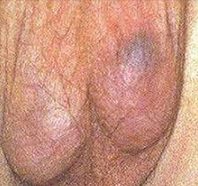
- peak age of occurrence is 7-12 years
- More than 50% of boys presenting with acute scrotal pain will have torsion of a testicular appendage
- can present with clinical features similar to testicular torsion, such as severe acute scrotal pain with nausea and vomiting.
- generally a self-limiting condition, are vestigial remnants with no known function
- differential includes
- ischemia (testicular torsion)
- infection (acute epididymo-orchitis)
- trauma (scrotal contusion, testis rupture).
- Symptoms
- The gradual onset of pain
- hydrocoele
- pain is more localized to the upper pole of the testis
- NO
- urinary symptoms
- systemic signs such as fever, nausea, or vomiting
- On exam
- palpable, localized mass with maximum tenderness
- the ‘blue dot’ sign (infarcted testicular appendage)
- scrotum usually appears normal, negative Prehn sign
- cremasteric reflex is typically intact

- Ultrasound
- hypoechogenic focus with normal or increased blood flow to the testis
- treatment
- conservative measures
- NSAIDs
- rest
- ice
- scrota
- support and elevation.
- the pain may last for several weeks
- Surgery is rarely indicated for a torsed testicular appendage.
- A scrotal exploration should only be performed if
- it is difficult to differentiate from testicular torsion
- increasing pain
- severe persistent pain unresponsive to conservative measures
Related